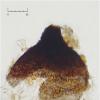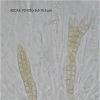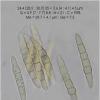
31-12-2025 19:27
Collected from loamy soil, at waterside (completel

30-12-2025 16:44
Pascal DucosBonjour,Une anamorphe rose stipitée, très nombre

30-12-2025 17:14
 Bernard CLESSE
Bernard CLESSE
Bonjour à toutes et tous,Pourriez-vous aider Albe

29-12-2025 10:15
Hulda Caroline HolteHello, I found and collected this propoloid ascom

30-12-2025 09:04
Hello.A Pyrenomycete sprouting sparsely but very d

29-12-2025 17:44
Isabelle CharissouBonjour,J'aimerais savoir si d'autres personnes au

12-11-2021 00:03
Lepista ZacariasHi everybody,A week ago in my fiels trip I noticed
Leptosphaeria ?
Garcia Susana,
14-03-2016 11:58
I found this ascomycete growing in sheet of Platanus.
Pseudotecios are inmersed, with a size of 150 um in diameter, and with a small neck about 40um.
Spores with 5 SEPTA.
I think it is Leptosphaeria, but I could not determine the species.
Any idea?
Thanks, greeting
Susana
Luc Bailly,
14-03-2016 22:56
Re : Leptosphaeria ?
Oh, strange. The spores make me think of Phaeosphaeria (Leptosphaeria p.p.) vagans, but that species is only noted on monocots, and only Poaceae.
Either there's some weed leaf coming along with the Platanus leaf, and sticked on it, otherwise I have no clue.
Or maybe someone with more knowledge will find the solution...
Cheers - LUC.
Either there's some weed leaf coming along with the Platanus leaf, and sticked on it, otherwise I have no clue.
Or maybe someone with more knowledge will find the solution...
Cheers - LUC.
Garcia Susana,
15-03-2016 08:07
Re : Leptosphaeria ?
Hola Luc
No, there was no grass stuck to the sheet. The species was immersed in platanus leaf. The sheet had many "black spots", the majority belonged to Pleospora herbarum. I found 2 perithecia of this type.
To be P. vagans should have spores with some longitudinal septum, and I not saw it. In any case, it would seem more to P. nigrans, but here the spores are greater.
Saludos
Susana
No, there was no grass stuck to the sheet. The species was immersed in platanus leaf. The sheet had many "black spots", the majority belonged to Pleospora herbarum. I found 2 perithecia of this type.
To be P. vagans should have spores with some longitudinal septum, and I not saw it. In any case, it would seem more to P. nigrans, but here the spores are greater.
Saludos
Susana





